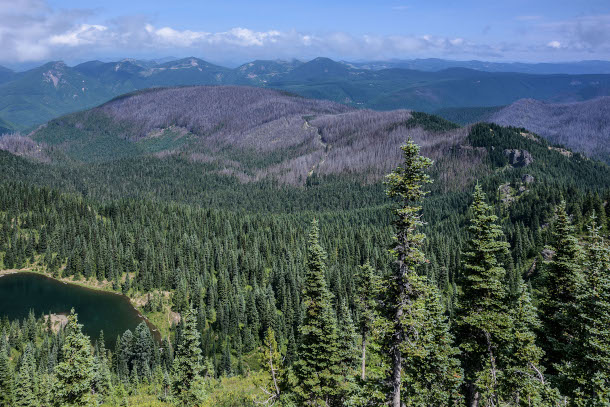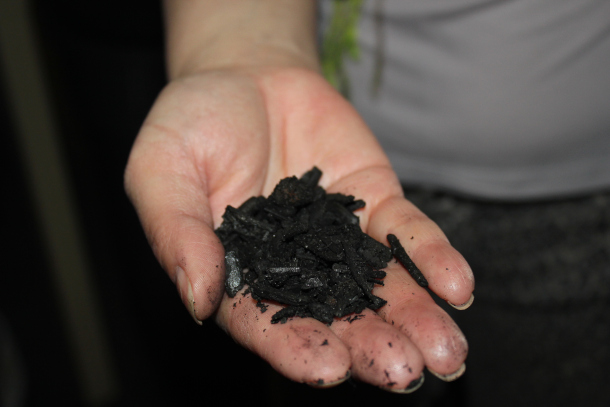Note on Emerging Science: Biochar and Irrigation
Air Date: Week of May 14, 2021

A partially-burned forest after a fire in Norse Peak, outside of Tacoma, Washington. (Photo: Richard Droker, Flickr, CC BY-NC-ND 2.0)
Intense drought in the Western United States has led to record-breaking wildfires in recent years, but new research shows that fire may indirectly help to conserve water in drought-prone areas. Living on Earth's Casey Troost has this note on emerging science about the benefits of biochar.
Transcript
TROOST: Intense drought in the Western US is fanning the flames of record wildfires in recent years, but new research shows that fire can indirectly help conserve water in drought-prone areas. The key is biochar, a sort of charcoal-dirt made of burned plant remnants. A study from Rice University found new evidence that biochar can slow the flow of water through sandy soils. Sandy soils cover much of the American west and lock in less water than soils mixed with silt or clay. This is because of surface area: Water sticks to surfaces, and the more surface area there is, the harder it is to move. For example, take a big straw versus ten small straws. You might be able to drink the same amount of water with both, but the small straws’ extra surface area will make you work harder. For soil, sandy soils are the big straw. They have bigger particles and gaps than soils with silt or clay, and this can make for thirsty plants. Without enough surface area in the soil, the water runs off the field too fast, and farmers in places like Nebraska have to pump up more than their crops actually need. That’s part of the reason why agriculture alone swallows 80% of US water consumption. But biochar can help reduce wasted water and keep more water on the land.

Biochar is a type of charcoal formed by burning organic material in a zero- or low-oxygen environment. (Photo: Marcia O’Connor, Flickr, CC BY-NC 2.0)
The researchers found that its unique shape breaks up the big spaces between sand particles, slowing down the water. And tiny pores inside each biochar particle absorb even more; under a microscope, it looks like a honeycomb. These new findings are great news for water conservation. The researchers found that farmers in certain parts of Nebraska can save nearly 40% of irrigated water by incorporating biochar into their sandy soils. And water isn’t the only benefit. The little pores in biochar also absorb atmospheric carbon, phosphorus, nitrogen, and other nutrients, and store them for plants to use. Just think - biochar is like a little lunch box and water bottle combined! That’s this week’s note on emerging science. I’m Casey Troost.
Links
Living on Earth wants to hear from you!
Living on Earth
62 Calef Highway, Suite 212
Lee, NH 03861
Telephone: 617-287-4121
E-mail: comments@loe.org
Newsletter [Click here]
Donate to Living on Earth!
Living on Earth is an independent media program and relies entirely on contributions from listeners and institutions supporting public service. Please donate now to preserve an independent environmental voice.
NewsletterLiving on Earth offers a weekly delivery of the show's rundown to your mailbox. Sign up for our newsletter today!
 Sailors For The Sea: Be the change you want to sea.
Sailors For The Sea: Be the change you want to sea.
 The Grantham Foundation for the Protection of the Environment: Committed to protecting and improving the health of the global environment.
The Grantham Foundation for the Protection of the Environment: Committed to protecting and improving the health of the global environment.
 Contribute to Living on Earth and receive, as our gift to you, an archival print of one of Mark Seth Lender's extraordinary wildlife photographs. Follow the link to see Mark's current collection of photographs.
Contribute to Living on Earth and receive, as our gift to you, an archival print of one of Mark Seth Lender's extraordinary wildlife photographs. Follow the link to see Mark's current collection of photographs.
 Buy a signed copy of Mark Seth Lender's book Smeagull the Seagull & support Living on Earth
Buy a signed copy of Mark Seth Lender's book Smeagull the Seagull & support Living on Earth

